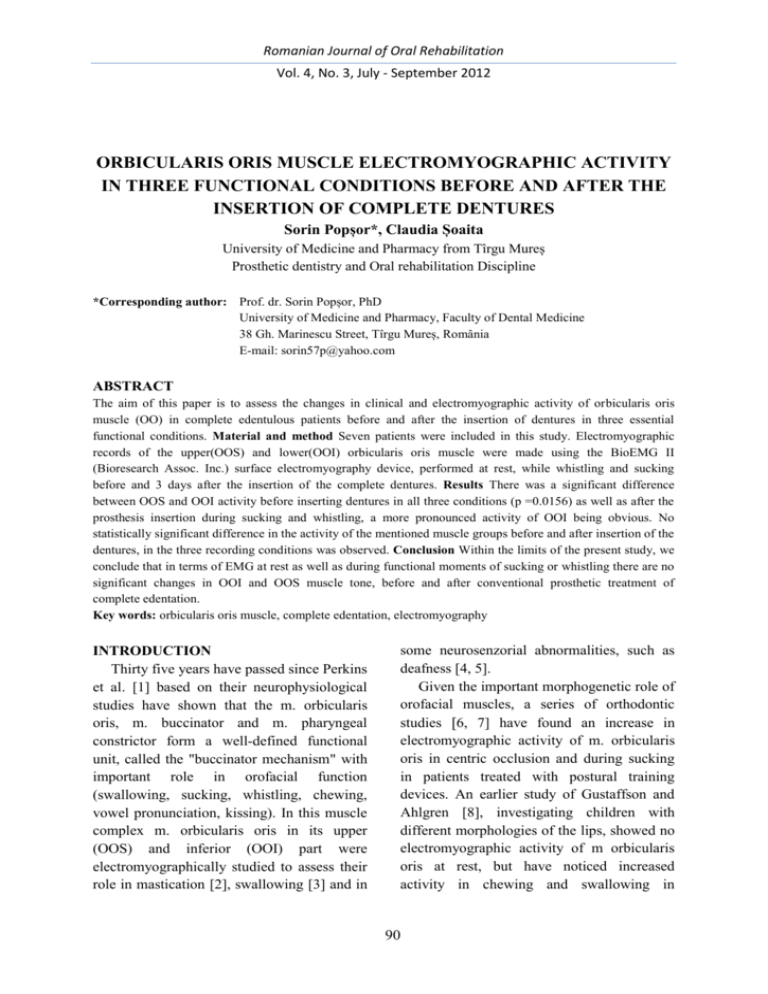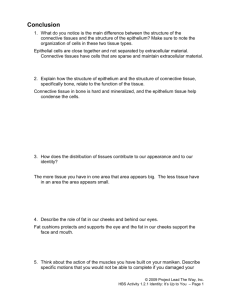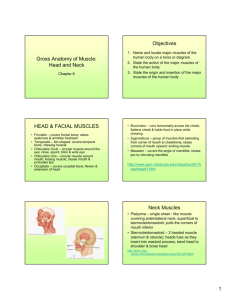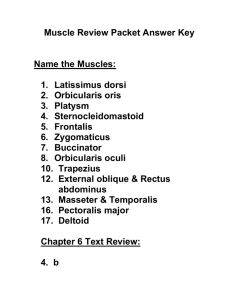Orbicularis-Oris-muscle-e... - Romanian Journal of Oral Rehabilitation
advertisement

Romanian Journal of Oral Rehabilitation Vol. 4, No. 3, July - September 2012 ORBICULARIS ORIS MUSCLE ELECTROMYOGRAPHIC ACTIVITY IN THREE FUNCTIONAL CONDITIONS BEFORE AND AFTER THE INSERTION OF COMPLETE DENTURES Sorin Popșor*, Claudia Șoaita University of Medicine and Pharmacy from Tîrgu Mureș Prosthetic dentistry and Oral rehabilitation Discipline *Corresponding author: Prof. dr. Sorin Popșor, PhD University of Medicine and Pharmacy, Faculty of Dental Medicine 38 Gh. Marinescu Street, Tîrgu Mureș, România E-mail: sorin57p@yahoo.com ABSTRACT The aim of this paper is to assess the changes in clinical and electromyographic activity of orbicularis oris muscle (OO) in complete edentulous patients before and after the insertion of dentures in three essential functional conditions. Material and method Seven patients were included in this study. Electromyographic records of the upper(OOS) and lower(OOI) orbicularis oris muscle were made using the BioEMG II (Bioresearch Assoc. Inc.) surface electromyography device, performed at rest, while whistling and sucking before and 3 days after the insertion of the complete dentures. Results There was a significant difference between OOS and OOI activity before inserting dentures in all three conditions (p =0.0156) as well as after the prosthesis insertion during sucking and whistling, a more pronounced activity of OOI being obvious. No statistically significant difference in the activity of the mentioned muscle groups before and after insertion of the dentures, in the three recording conditions was observed. Conclusion Within the limits of the present study, we conclude that in terms of EMG at rest as well as during functional moments of sucking or whistling there are no significant changes in OOI and OOS muscle tone, before and after conventional prosthetic treatment of complete edentation. Key words: orbicularis oris muscle, complete edentation, electromyography INTRODUCTION Thirty five years have passed since Perkins et al. [1] based on their neurophysiological studies have shown that the m. orbicularis oris, m. buccinator and m. pharyngeal constrictor form a well-defined functional unit, called the "buccinator mechanism" with important role in orofacial function (swallowing, sucking, whistling, chewing, vowel pronunciation, kissing). In this muscle complex m. orbicularis oris in its upper (OOS) and inferior (OOI) part were electromyographically studied to assess their role in mastication [2], swallowing [3] and in some neurosenzorial abnormalities, such as deafness [4, 5]. Given the important morphogenetic role of orofacial muscles, a series of orthodontic studies [6, 7] have found an increase in electromyographic activity of m. orbicularis oris in centric occlusion and during sucking in patients treated with postural training devices. An earlier study of Gustaffson and Ahlgren [8], investigating children with different morphologies of the lips, showed no electromyographic activity of m orbicularis oris at rest, but have noticed increased activity in chewing and swallowing in 90 Romanian Journal of Oral Rehabilitation Vol. 4, No. 3, July - September 2012 children incompetence of the lips, which was notified later by other authors [9, 10, 11]. Tryde and Tallgren [12] studying the electromyographic activity of the muscles of the lips during swallowing in dentures wearers found that OOI electromyographic activity was stronger than the OOS one. Our aim was to assess the changes in clinical and electromyographic activity of OO muscle in complete edentulous patients before and after the insertion of dentures in three essential functional requirements (posture, whistling and sucking) in terms of total edentulous diagnostic, therapy and evolution. MATERIAL AND METHOD Patients. Seven patients (1F and 6 M, mean age 61 years) presented for treatment with conventional mobile prostheses were included in the study. All participants were asked for informed consent regarding the electromyographic examination as a means of evaluating the therapeutical results. Electromyography. Electromyographic records of the orbicularis oris muscle were made using the BioEMG II (Bioresearch Assoc. Inc.) surface electromyography device, which is specifically intended to record the activity of craniofacial muscles. Fig. 1. M. orbicularis oris. Anatomical view We used the TA-R channel for OOS and the TA-L one for OOI. The placement of the adhesive surface bipolar electrodes was made according to the anatomical disposition of muscle fibres (Fig. 1), parallel to this, on the right side third of each of the two muscles (Fig. 2 and 3), in accordance with the protocols proposed by Barrel & Moyers [13] and Vaiman [14]. Adhesive ground electrode was attached to the patient's right shoulder. The electromyographic records were performed before and 3 days after the insertion of the complete dentures in the mouth during three conditions: rest, while whistling and sucking. For each of these conditions, from the 10 seconds of recording three sections of 2.5 seconds for the two investigated muscles, were analysed. The mean amplitude of electromyographic signals calculated by the software device (BioPack) (Fig. 4) were listed in the tables, the results were expressed graphically and statistically interpreted. Statistics. For the statistical evaluation of the differences in electromyographic activity before and after the prosthetic treatment, the Wilcoxon matched-pairs signed rank was used. To determine the two-tailed p value at a significance level of 0.05, GraphPad Prism software version 5.0 was used. Fig. 2, 3. Bio EMG II device and electrodes placement 91 Romanian Journal of Oral Rehabilitation Vol. 4, No. 3, July - September 2012 Fig. 4. The BioPack software review mode of the recordings. The TA-R channel for OOS and the TA-L one for OOI were used. RESULTS The Tables II, III and IV present the mean amplitude of electromyographic signals picked- up from the investigated muscles of the lips in three conditions of registration. There was a significant difference between OOS and OOI activity before inserting dentures in all three conditions (p=0.0156). After the prosthesis insertion during sucking and whistling, a more pronounced activity of OOI was obvious. No statistically significant difference in the activity of the mentioned muscle groups before and after the insertion of the dentures, in the three recording conditions could be seen (Table I). Rest two-tailed p value Sucking two-tailed p value Whistling two-tailed p value OOS 1 vs. OOS 2 0.9325 0.1563 0.8125 OOI 1 vs. OOI 2 0.4375 0.3750 0.0781 Table I. Differences in activity of both muscles in the three recording conditions before and after insertion of dentures (Wilcoxon matched-pairs signed rank test). Patient OOS 1 1.2 D.J 4.6 E.S 3.6 M.I 3.0 M.T 2.8 T.A 2.2 C.L 3.4 Sz.A OOI 1 3.3 7.6 4.8 4.3 4.0 3.8 4.4 OOS 2 1.4 2.8 2.6 3.8 3.1 2.8 4.0 00I 2 2.3 1.9 6.0 3.5 4.3 3.8 3.9 Table II. The mean amplitude of EMG signals (in microvolts) picked-up from the orbicularis oris muscle at rest (OOS = orbicularis oris superior, OOI =orbicularis oris inferior) before (1) and after (2) insertion of the dentures. Patient D.J E.S M.I M.T T.A C.L Sz.A OOS1 22.2 39.7 53.0 38.4 42.4 38.2 28.9 OOI 1 77.3 68.4 88.0 62.3 78.8 65.3 60.4 OOS2 20.3 37.0 44.1 22.2 38.0 44.0 26.0 OOI 2 51.9 66.8 51.4 50.6 66.2 77.1 74.3 Table III. Mean amplitude of m. orbicularis oris EMG signals (in microvolts) while sucking, before and after inserting dentures 92 Romanian Journal of Oral Rehabilitation Vol. 4, No. 3, July - September 2012 Fig. 5. Distribution of mean values of EMG signals at rest (95% CI) Patient E.S M.I M.T T.A C.L Sz.A OOS1 OOI1 OOS2 OOI2 17.6 34.4 37.2 49.0 22.7 36.4 33.0 60.1 82.7 45.0 61.6 61.2 82.0 72.2 11.0 41.9 43.0 45.3 20.2 34.0 38.0 35.2 82.6 53.9 50.6 56.3 70.0 62.8 Fig. 6. Distribution of EMG signals mean values during sucking (95% CI) Table IV. The EMG signals mean amplitude (in microvolts) of orbicularis oris muscle while whistling, before and after inserting dentures DISCUSSIONS The orbicularis oris muscle is one which by its fiber orientation has a positive action to maintain the stability of the dentures. Placing the artificial teeth so as not to interfere with muscle activity and to enable the retention and stability action of the musculature is a priority of the complete edentation treatment [15, 16, 17]. For this purpose various Fig. 7. Distribution of EMG signals mean values during whistling (95% CI) prosthetic techniques have been imagined [18, 19, 20, 21]. The tonicity of OO muscles can be assessed under different electromyographic examination. According to available literature, some studies have evaluated the electromyographic activity of the muscles during different syllables before and after insertion of dentures [22]. OOI muscle generally present higher mean values 93 Romanian Journal of Oral Rehabilitation Vol. 4, No. 3, July - September 2012 of electromyographic activity compared with those recorded in OOS, both before and after insertion of dentures. Electromyographic values were also higher after insertion of dentures. Redegard Ingervall [23] and have published their research on the orbicularis oris muscles before and after insertion of dentures, but their electromyographic records were achieved in centric occlusion. Our study used three conditions for electromyographic registration proper to OO muscles functionality (rest, sucking, whistling), two of which are well known functional movements to establish the prosthetic field limits and to place de anterior artificial teeth in the neutral zone. The results showing more elevated electromyographic activity in OOI compared with OOS in all three conditions before prosthetic rehabilitation, as well as during the whistle and while sucking with the inserted dentures are consistent with those obtained in other functional conditions, earlier presented in this paper. The BioEMG II device used in our study is specifically destined to record the head and neck muscle activity and it is the only surface EMG system that is entirely gainless. In the available literature we found orthodontic studies using the BioEMG II electromyographic system for orbicularis oris muscles. Saccucci et al. [24] used the BioEMG II to assess the changes caused by the functional devices and found that they improved muscle contraction after treatment. The subject of the thesis developed by Daniela Maria Afonso Estavos [25] in 2011 using BioEMG II electromyographic system was to establish the relationship between the OO muscles and the irregularities in the anterior mandibular arch. She concluded that electromyographic activity of the orbicularis oris muscles cannot be related to irregularities in the mandibular arch, in either functional moments. This finding is consistent with those observed by us in complete edentation, the denture insertion actually represents a change in edentulous arch. Orbicularis oris muscle activity has undergone no significant change from the original condition after prosthetic therapy in any of the recorded conditions. The relatively few patients number, however, is a limitation of our study. We also believe that further late electromyographic evaluation after 6 months would be useful, when probably the patient adaptation to dentures may manifest as changes in muscle tone. CONCLUSIONS Within the limits of the present study, we conclude that in terms of EMG at rest as well as in functional moments of sucking or whistling there are no significant changes in OOI and OOS muscle tone, before and after conventional prosthetic treatment of complete edentation. REFERENCES 1. Perkins R.E., Blanton P.L., Biggs N.L. Electromyographic Analysis of the Buccinator Mechanism in Human Beings, JDR, 1977; 56(7): 783-794. 2. Hanawa S., Tsuboi A., Watanabe M., Sasaki K. EMG study for perioral facal muscles function during mastication, J Oral Rehabil, 2008 Mar; 35(3): 159-170. 3. Ding R., Larson CR., Logemann JA, Rademaker AW. Surface electromyographic and electroglottographic studies in normal subjects under two swallow conditions: normal and during the Mendelsohn manuever, Dysphagia, 2002 Winter; 17(1) 1-12. 4. Regalo SC, Vitti M., Moraes Maria Theresa Bagaiolo, Semprini Marisa, de Felicio Claudia Maria, de Mattos Maria da Gloria Chiarello, Hallak JEC, Moreto Santos Carla. Electromyographic analysis of the orbicularis oris muscle in oralized deaf individuals, Braz.Dent.J, 2005; 16(3): 1-6. 94 Romanian Journal of Oral Rehabilitation Vol. 4, No. 3, July - September 2012 5. Regalo SC, Vitti M, Hallak JE, Siessere S., Pagnano VO, Semprini M. Electromyographic analysis of upper and lower fascicles of the orbicularis oris muscle in deaf individuals, in mandibular rest position, compared to hearers. Electromyogr Clin Neurophysiol, 2006; Jul-Aug 46(4): 211-215. 6. Uysal T, Yagaci A, Kara S, Okkesim S. Influence of pre-orthodontic trainer treatment on the perioral and masticatory muscles in patients with Class II division 1 malocclusion, Eur J Orthod, 2012 Feb;34(1): 96-101. 7. Yagaci A, Uysal T, Kara S, Okkesim S. The effects of myofunctional appliance treatment on the perioral and masticatory muscles in Class II, Division 1 patients, World J Orthod, 2010 Summer; 11(2): 117-122. 8. Gustaffson M, Ahlegren J. Mentalis and orbicularis oris activity in children with incompetent lips: An electromyographic and cephalometric study, Acta Odontologica Scandinavica, 1975; 33(6): 355363. 9. Tosello DO, Vitti M, Berzin F. EMG activity of the orbicularis oris and mentalis muscles in children with maloclusion, incompetent lips and atypical swallowing-part II, J Oral Rehabil, 1999 Aug; 26(8): 644-649. 10. Siqueira VCV, Sousa MA, Berzin F, Casarini CAS. Electromyographic analysis of the orbicularis oris muscle in youngsters with Class II, Division 1 and normal occlusion. Dental Press J Orthod,2011 Sept-Oct; 16(5): 54-61. 11. Souza DR, Semeghini Tatiana Adamov, Kroll LB, Berzin F. Oral Myofunctional and Electromyographic Evaluation of the Orbicularis Oris and mentalis Muscles in Patients with Clas II/1 Malocclusion Submitted to First Premolar Extraction, J Appl Oral Sci 2008; 16(3): 226-231. 12. Tallgren A, Tryde G. Swallowing activity of lip muscles in patients with a complete upper and a partial lower denture. J Oral Rehabil, 1992 Jul; 19(4): 329-341. 13. Baril C, Moyers RE. An Electromyographic Analysis of the Temporalis Muscles and certain Facial Muscles in Thumb-and Finger-sucking Patients, J Dent Res 1960 May-June; 536-552 14. Vaiman M. Standardization of surface electromyography utilized to evaluate patients with dysphagia. Head&Face Medicine 2007; 3: 26-31. 15. Beresin VE, Schiesser FJ. The neutral zone in complete dentures. J Prosthet Dent 1976 Oct; 36(4): 356-367. 16. Chandra SS. Management of a severely resorbed mandibular ridge with the neutral zone technique. Contemp Clin Dent 2010 Jan-Mar; 1(1): 36-39. 17. van Waas MA. Neutral zone. An anatomic space which is often neglected while fabricating removable complete dentures, Ned Tijdschr Tandheelkd, 2011 Nov; 118(11): 563-567. 18. Lynch CD, Allen PF. Overcoming the unstable mandibular complete denture: the neutral zone impression technique, Dent Update 2006 Jan-Feb; 33(1): 21-22; 24-26. 19. Demirel F, Oktemer M. The relations between alveolar ridge and the teeth located in neutral zone, J Marmara Univ Dent Fac 1996 Sep; 2(2-3): 562-566. 20. 20 Gahan MJ, Walmsley AD. The neutral zone impression revisited, Br Dent J 2005 Mar12; 198(5): 269-272 21. Kursoglu P., Ari N, Calikkocaoglu S. Using tissue conditioner material in neutral zone technique, NYState Dent J, 2007 Jan; 73(1):40-42 22. Santos M Carla, Vitti M,Mattos OF Maria, Semprini Marisa, Paranhos OF Helena, Hallak J, Regalo SC. Effect of denture qualityon perioral muscle activity during speech, Braz J Oral Sci 2005; 4(14): 801-805. 23. Ingervall B, Redegard B. An electromyographic study of masticatory and lip muscle function in patients with complete dentures, J Prosthet Dent 1980; 43: 266-271 24. SaccucciM., Tecco S., Ierardoa G., Luzzi V., Festa F., Polimeni A. Effects of interceptive orthodontics on orbicular muscle activity: a surface electromyographic study in children, J Electromyogr Kinesiol, 2011 Aug;21(4): 665-671. 25. Daniela Maria Estavos Afonso: Harmonia labial como factor de Estabilidade do Tratamento Ortodontico. Dissertação de candidatura ao grau de Mestre apresentada à Faculdade de Medicina Dentária da Universidade do Porto, 2011. 95








